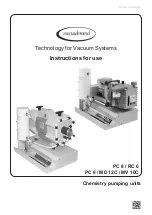
Installation and electrical connection
en
Installation and operating instructions Wilo-DrainLift SANI-L
15
ƒ
All connection cables must be laid properly. The connection cables must not pose
any risk (i.e. tripping, damage during operation). Check whether the cable cross-sec-
tion and the cable length are sufficient for the selected installation type.
ƒ
The mounted switchgear is not overflow-proof. Install the switchgear at an ad-
equate height. Ensure good operation!
Installation in the pump chamber
DANGER
Risk of fatal injury due to dangerous lone working practices!
Work in chambers and narrow rooms as well as work involving risk of falling are dan-
gerous work. Such work may not be carried out autonomously! A second person
must be present for safety reasons.
WARNING
Head injuries due to lack of protective equipment!
Danger of (serious) injuries during work. If lifting equipment is used, wear a safety
helmet!
CAUTION
Beware of frost!
Frost can cause malfunctions and damage. Pay attention to local frost depths. If the
unit or pressure outlet are in the freezing zone, take the unit out of operation during
freezing periods.
Also adhere to the following points if the lifting unit is installed in a pump chamber:
ƒ
Toxic or asphyxiating gases may build up during work. Ensure adequate ventilation.
Observe protective measures in accordance with work regulations (gas measure-
ment, carry a gas detector with you).
ƒ
Take immediate countermeasures if there is a build-up of toxic or asphyxiating
gases!
ƒ
Note the diagonal dimension of the lifting unit.
ƒ
Install lifting equipment: even surface, clean, firm base. Warehouse and installation
location must be easily accessible.
ƒ
Attach two transport straps to the lifting unit. Secure the transport straps against
slipping! Only use lifting gear that has been technically approved.
ƒ
If the weather conditions (e.g. ice formation, strong wind) mean it is no longer pos-
sible to work safely, stop work.
6.4.1
Note on fixation material
The lifting unit can be installed on various constructions (concrete, steel, etc.). Select
the fixation material which is suitable for the relevant construction. For correct installa-
tion, observe the following instructions for the fixation material:
ƒ
Avoid tearing or chipping of the construction surface,
observe the minimum edge
distances
.
ƒ
Ensure tight and secure installation,
adhere to the prescribed borehole depth
.
ƒ
Drilling dust impairs holding strength,
always blow out or vacuum out the bore-
hole
.
ƒ
Only use components (e.g. screws, anchors, mortar cartridges) which are in perfect
condition.
6.4.2
Note on pipework
The pipework is subjected to different pressures during operation. Pressure peaks can
also occur (e.g. when closing the swing check valve) which may be several times higher
than the pump pressure, depending on the operating conditions. These different pres-
sures put a strain on the piping and the pipe adaptors. In order to ensure safe and fault-
less operation, the piping and pipe adaptors must be checked based on the following
parameters and designed according to the requirements:
ƒ
Pipes are self-supporting.
No tensile or compressive forces must act on the lifting unit.
ƒ
Pressure resistance of pipework and pipe adaptors
ƒ
Tensile strength of the pipe adaptors (= longitudinal force fit connection)
ƒ
Connect the pipes free of stress and vibrations.
















































